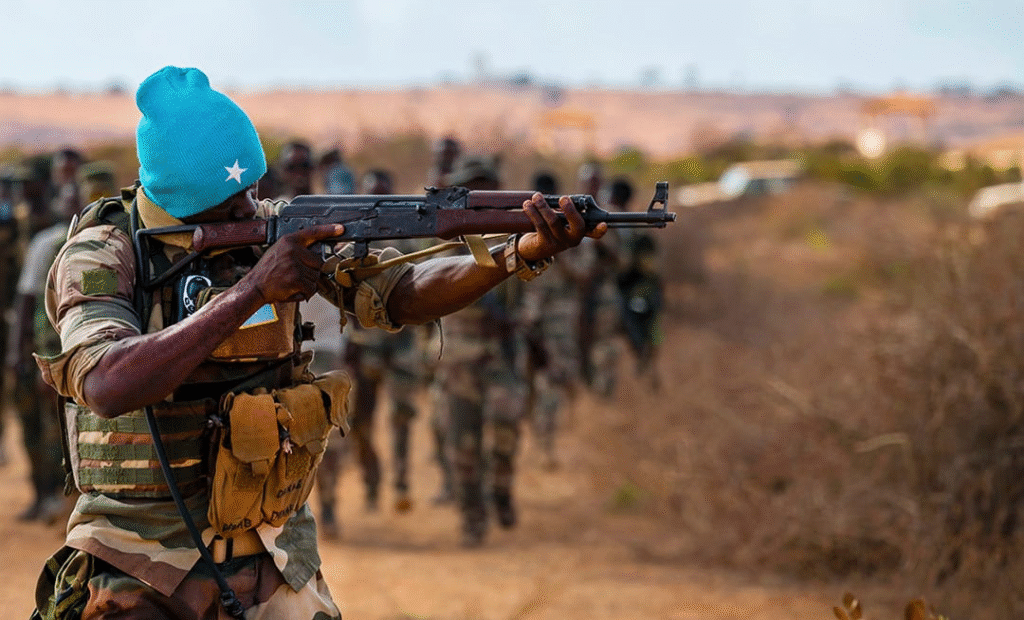Somalia significantly expanded its employment of drones—primarily Bayraktar TB2s operated either by Turkish personnel or Somali agencies with Turkish logistical support—to strike Al‑Shabaab targets across southern and central Somalia. These unmanned systems, deployed in coordination with Somali intelligence and the Somali Air Force, began hitting training camps, weapon depots, and leadership strongholds in regions such as Lower Shabelle, Middle Shabelle, and Middle Jubba .

Key Operations & Leadership Strikes
One notable operation in May 2025 involved coordinated TB2 strikes on Al‑Shabaab installations near Jilib, Sablaale, and Kunya Barow. The attacks destroyed major arms stockpiles and command centers, killing at least 29 senior militants—many foreign—and disrupting the group’s command infrastructure . Similar raids earlier in 2025 continued these disruptions, although the militants retained the ability to mount large-scale counterattacks .
U.S. Drone Strikes Support Somali Forces
Alongside Turkish-supported operations, U.S. AFRICOM also resumed drone strikes. In February 2022, for instance, the U.S. struck Al‑Shabaab fighters near Duduble, reportedly eliminating multiple combatants without civilian casualties. Later in June that year, U.S. forces launched additional airstrikes in support of Somali ground forces post‑deployment of U.S. special operations teams in Somalia .
Political Backing for Drone Campaign
After AFRICOM eliminated senior Al‑Shabaab leaders, Somali security services to expanded drone use to drive the group from the country .
Impact on Al‑Shabaab Tactics and Morale

Analysts note that drone strikes have induced caution within Al‑Shabaab. Studies suggest that the threat of precision attacks forced the group to modify its operations—limiting large-scale assaults and increasing attacks on soft civilian targets instead . Still, the group’s decentralized nature and ability to replace lost leaders has limited the long-term strategic gains of drone campaigns.
Humanitarian Concerns and Civilian Casualties
Despite their tactical impact, drone strikes have also caused serious civilian harm. A TB2 drone struck a farm near Bagdad village in Lower Shabelle, hitting civilians gathered there—reportedly killing 23 (including 14 children) and injuring another 17. Amnesty International has called the incident potentially a war crime and questioned whether Turkish personnel, Somali forces, or a combination controlled the drones . The Somali government defended the operation, stating it killed over 30 Al‑Shabaab militants in collaboration with “international partners” .
Accountability & Oversight Challenges
The ambiguity over who piloted the drones—a significant oversight issue—is tied to broader questions about how drones were acquired and managed. The UN Panel of Experts noted that Türkiye asserted control of the TB2 fleet, denying a formal transfer to Somalia in 2022, thereby potentially breaching UN arms embargo rules. Thus, many operations have taken place in a legal grey area .
Institutional Expansion: New Infrastructure & Command Posts
The Somali government has sought to build a more robust national drone infrastructure. In late 2023, military construction began on a new airbase in Middle Shabelle’s Wargaadhi, intended to support drone command functions and extend aerial coverage into newly contested provinces. The facility is expected to be integrated into the Somali Air Force’s operational network, signaling growing institutionalization of drone warfare .
Strategic Assessment & Future Direction
By mid‑2025, drone strikes—particularly by Turkish-operated TB2s—have become central to Somalia’s counter‑Al‑Shabaab strategy, complementing offensives and enabling operations in remote regions. Between late 2024 and early 2025, frequency of drone-assisted missions nearly quadrupled compared to 2024, though Al‑Shabaab remained capable of mounting significant attacks in liberated areas .
While U.S. strikes continue, Turkey has emerged as the primary source of Somali doses of drone airpower—often operating from Mogadishu with Somali targeting support. This has triggered debates over civilian protection, transparency, and accountability. RealClearDefense commentary and advocacy groups emphasize the importance of strict targeting protocols to minimize collateral harm even as drones help deter and degrade militant operations .


